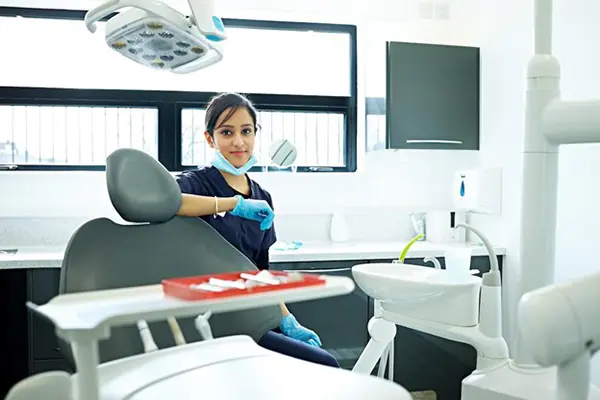 Dental assistants are amazingly versatile professionals who play a vital role in maintaining the flow and positive atmosphere of the modern dental clinic. Their skill set incorporates not only administrative and select clinical tasks but also the underrated power of communication. Whether they are conversing with patients or professionals, DAs make a difference with their words, tone of voice and body language.
Dental assistants are amazingly versatile professionals who play a vital role in maintaining the flow and positive atmosphere of the modern dental clinic. Their skill set incorporates not only administrative and select clinical tasks but also the underrated power of communication. Whether they are conversing with patients or professionals, DAs make a difference with their words, tone of voice and body language.
Because their interactions with patients, dentists and hygienists have such an enormous impact, it is imperative that DAs know how to get important messages across. This should be a core component of the training process, as communication underscores everything that happens in the dental environment. To that end, we will discuss all the essentials of communication in dentistry: why it matters, what role it plays, and how to communicate as a dental assistant.
Why Is Patient Communication Important as a Dental Assistant?
Patient communication is important in all areas and levels of dentistry because it promotes a safe, healthy and productive clinical environment. Every process and procedure that takes place in a dental practice relies on effective communication; without it, patients and professionals would have no idea what to expect nor how to behave.
As Dr. Joseph Rosenwald points out in Dentistry iQ, “Dentistry is both an art and a science.” He adds that, when dentistry professionals focus too much on the clinical components of the field, they miss out on the importance of truly connecting with and understanding their patients.1
Ultimately, Dr. Rosenfeld feels that “patients want to be heard” and that it is the dental professional’s responsibility to listen and communicate in a way that acknowledges and shows respect for their “problems, fears and past experiences.” Over time, this can lead to vast improvements not only in patient compliance and satisfaction but also in clinical outcomes.
While there is no denying the value of communication at all levels of dentistry, this takes a notable step up in importance for dental assistants. Often providing powerful first impressions and acting as liaisons between patients and dentists (or hygienists), DAs often spend the most time conversing directly with patients and therefore must master empathetic and impactful communication.
Effective communication with patients not only makes them feel comfortable, but it also gets them in the door in the first place. Kindness and empathy are core strategies for how to attract new dental patients — if a practice has a reputation for making patients feel stressed or judged, they will avoid it regardless of the dentist’s clinical skills.
What Is the Process for Communicating Properly?
Effective communication is nuanced. There is no one style or strategy that will resonate equally well with all patients or team members. It is up to DAs to discern what each situation calls for and how they can adjust their body language, tone of voice, and conversational content accordingly.
Beyond this, DAs must communicate within the scope of their practice. In general, DAs can cover the basics of general oral or preventative care and, of course, provide comfort to worried patients. Otherwise, for concerns beyond the scope of the DA, Dentistry iQ recommends a simple response such as, “I’m not a dentist and only a dentist can diagnose,” adding that these types of questions should then be reviewed with the dentist.2
In general, success in communication as a DA relies on the following qualities:
Be Friendly
A kind greeting can make a world of difference. Early impressions truly matter and, if patients feel welcome from the moment they enter the clinic, they are more likely to cooperate and less likely to continue feeling anxious throughout their visit.
Dentistry iQ recommends making friendly conversation, explaining that it’s perfectly fine (and even encouraged) to ask them about their family members, hobbies or vacation plans. As this resource points out, “Most people like to talk about themselves.”
Make an effort to remember these details, even if they don’t seem important. Dental coordinator Ashley Johnson tells the Dental Assisting National Board (DANB) that the goal may be as simple as letting patients know that they’re not just another number.” Even just remembering if they have a cat or the cat’s name can totally turn a patient’s attitude or day around when they’re in the chair.”3
Show Empathy
Have you ever felt nervous or ill at ease prior to a dental or medical appointment? If so, you should be thoroughly familiar with the whirlwind of emotions that patients experience.
These concerns may be alleviated, to some extent, through the power of empathy. This means listening to patients’ fears and assuring them that you understand just how frightening appointments and procedures can seem. Once patients feel acknowledged, they will respond better to suggestions for moving past their fears.
Be Informative
Small talk can be helpful, but it shouldn’t sideline actionable information that genuinely helps patients. Rather, DAs can provide helpful insight into what occurs during a checkup or procedure and what patients can expect every step of the way. Equipped with this understanding, patients are less likely to feel anxious or overwhelmed.
Dental assistants can also clue patients in on dental practices or habits that might improve their oral health. Experts at the Dental Assisting National Board (DANB) add that DAs can reinforce messaging that dentists have already provided for their patients but in a potentially less intimidating manner.
Dental coordinator Ashley Johnson tells the DANB, “Sometimes, [patients] can hear it three different times from the dentist, but they might not understand it until you as a dental assistant change your wording.”
What Should I Avoid When Talking to Dental Patients?
Sometimes, what DAs don’t say is as impactful as the content of their conversations. Remember: every dental patient wants to feel cared for and respected. This means maintaining a positive tone and resisting the urge to lecture. Yes, it is important to be informative, but this should not come across as judgmental.
Similarly, scare tactics must be avoided. While patients should be cautioned against engaging in certain harmful behaviors, the goal should not be to terrify them or to make them worry. Rather, it is the DA’s prerogative to focus on desirable habits that patients can develop over time. This will ultimately encourage them to take ownership over their oral health and is more likely to result in meaningful change than fear-oriented strategies.
Don’t Use Dental Jargon
While all dental assistants should possess a thorough understanding of dental terminology, this should be reserved for communicating with fellow dental team members. When conversing with patients, however, language should be as simple and clear as possible. This means avoiding complex dental terms that the average patient may struggle to understand.
Research published in the Journal of Education and Health Promotion indicates that, while jargon remains frequently used in many dental practices and other clinical settings, it tends to get in the way of patient-clinician relationships.4 What’s more, this can impede patient understanding and comfort. The study adds that, while some dental terminology may occasionally need to be used, it must be “explained in simple, plain language to the patients.”
How Communication Prepares Patients for Procedures
Effective communication is always vital in dentistry, but this takes on a new dynamic when patients need to undergo dental procedures. This is when many patients feel the most anxious, hence, the need for a detailed and empathetic overview of the procedure, plus clear instructions for how the patient should behave every step of the way.
Walk Patients Through the Procedure Process
As we’ve discussed, walking patients through dental processes can be helpful. This is particularly vital when patients face major procedures, which can be intimidating.
An empathetic, step-by-step overview may alleviate fear while also letting patients know how they should behave throughout the process and what they can do to help the procedure run smoothly.
Details worth mentioning while preparing patients for procedures include:
- How long the procedure is expected to take.
- Which types (if any) of anesthetic will be used.
- Who will be present for the procedure (dentists, hygienists and DAs, for example).
- Which stop signals patients can use to communicate during the procedure.
While chatting about the procedure, DAs should be willing to answer patient questions or, if necessary, refer patients to hygienists or dentists for additional insight. There may be a need to repeat previously relayed details throughout the course of the appointment or procedure, as patients are apt to forget — especially if they are feeling anxious.
Update on Next Steps
Following the procedure, patients may feel relieved but also worried about how their care will proceed. Again, a basic walk-through can be helpful. DAs can highlight which appointments or follow-up procedures may be necessary and what will happen during those visits. They can also let patients know what to expect in terms of their oral health moving forward — how long it typically takes to fully recover from a particular procedure, for example.
Be Specific About What You Need the Patient to Do
Patients understand that they should engage in healthy oral habits and behaviors, but many struggle to remember what these look like, especially in the context of specific procedures. They will need clear instructions about how to proceed.
For example: DAs can remind patients whether they are supposed to avoid specific foods or beverages for a certain amount of time after the appointment. They can also provide insight into recommended strategies for brushing, flossing or using gauze, if necessary.
Be an Active Listener
Even when they know exactly how procedures will unfold, patients may worry about the process or its aftermath. Some require, above all else, the chance to express these concerns to dental professionals who truly care about their comfort and wellbeing. How DAs conduct these conversations and respond to patients matters.
Both patients and dental professionals communicate more effectively when they get the opportunity to converse with someone who listens actively. This goes beyond merely hearing the words spoken by the other person and, instead, encompasses a deeper understanding of the full message that individual is trying to get across. A variety of factors may play into this messaging, including the content of the conversation as well as body language, tone of voice, and contextual clues.
For a dental assistant, active listening might mean paying attention to various cues from patients to reveal how they are really feeling, even if they don’t verbally provide such insight. Similarly, DAs can engage in active listening while discussing concerns with dentists or hygienists. This version of listening makes the other person feel seen and respected — and it can promote a more positive and understanding clinical environment.
Building Dental Office Rapport
The dental office can be a stressful environment. With so many patients and difficult procedures to handle, it’s easy to see why dentists and hygienists often feel tense. This can impact dental assistants as well, but DAs have the power to turn things around and build a positive environment.
Often, seemingly small details make all the difference, cutting through the tension and helping both patients and professionals relax. Some of the same strategies that work well with patients can also help dentists and hygienists feel supported.
Active listening also matters. From the DA’s perspective, this means making it abundantly clear that all instructions from the dentist or hygienists have been heard and understood.
Develop Dental Assisting Communication Skills
Learn how to become a dental assistant with Carrington College and help patients feel at ease!
Sources:
- Rosenwald, J. “How good communication leads to our best clinical work in dentistry.” Dentistry iQ.
- Tighe, K. “The many duties of dental assistants, identified and explained.” Dentistry iQ.
- “Dental assistants play key role in patient health.” Dental Assisting National Board.
- Kumar, P, et al. “Role of jargon in the patient–doctor communication in the dental healthcare sector—A systematic review and meta-analysis.” Journal of Education and Health Promotion.



